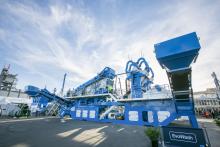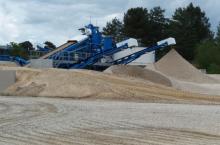New equipment in the stone washing industry is helping produce high quality products. Patrick Smith reports.
Washed aggregate is required for many markets and applications, and finished product needs to meet specifications outlined by the ever stringent and demanding world markets, says DUO, a distributor for several European and USA equipment manufacturers.
“Where dry screening was accepted in the past, washing and scrubbing are now required to produce a silt-free product," Duo says.
[caption id="attachment_84445" align="alignright" width="229"] Sean Loughran, MWS director, with the McCloskey Washing Systems' Sandstorm 620[/caption]
Sean Loughran, MWS director, with the McCloskey Washing Systems' Sandstorm 620[/caption]
A typical rinsing set-up would be used when the material does not require scrubbing, only rinsing to remove small particles of silt and fines to produce a clean end-product.
“The scrubbing process is required when dry and other deleterious materials are present, the process of high speed scrubbing is an accepted method. Scrubbing works on the principle of working material against material to remove clay and other materials from stone before moving on to the next stage.”
Terex Washing Systems, which supplies advanced wet processing solutions for mineral washing needs in aggregates, recycling, industrial sands and mining, has globally launched its Terex AquaClear Water Management Solutions.
“It really is an exciting time for TWS [Terex Washing Systems] and we are delighted to be able to offer an end-to-end solution for washing and water management from TWS, a single supplier,” says Oliver Donnelly, global business line director, Terex Washing Systems.
[caption id="attachment_84444" align="alignleft" width="324"] Haver & Boecker's new skid-mounted Hydro-Clean 1000 wash plant[/caption]
Haver & Boecker's new skid-mounted Hydro-Clean 1000 wash plant[/caption]
"A lot of our customers are into water management. It’s a growing sector given the way environmental legislation is headed in certain regions and territories.”
Water Management Solutions are made up from three main components. A flocculent dosing plant and thickener tank can be used to recycle up to 80% of the water used in the washing process. This basic method still involves the use of ponds but on a smaller scale as the sludge sent to the ponds is of a much higher specific gravity (1.5sg).
The next stage is to incorporate a filter press which hydrates this thickened material even further, typically down to 25% moisture. The filter press eliminates the need for ponds as the sludge is hydrated to a material/cake which can be handled by a loading shovel. This cake can be used as a lining or capping material.
Donnelly says Terex Washing Systems was due to begin manufacturing the Terex AquaClear Water Management Solutions in Dungannon, Northern Ireland, later this year, working alongside strategic alliance partners, Valley Equipment Company, Portland, Oregon, USA.
“Through our strategic alliance, [for North American customers] we can send a filter press fully built up. With Valley Equipment, we’re working with partners who have been in the industry years and years,” says Donnelly.
[caption id="attachment_84443" align="alignright" width="352"] Terex Washing Systems new AquaClear Water[/caption]
Terex Washing Systems new AquaClear Water[/caption]
Haver & Boecker, a equipment manufacturer and in aggregates and mining applications, has launched the skid-mounted Hydro-Clean 1000 Wash Plant as a complete solution. In addition to a Hydro-Clean 1000 washing system combined with a single-deck, linear-stroke Tyler L-Class vibrating rinse screen, Haver & Boecker offers semi-portability by mounting the complete system on a custom skid structure. The opportunity to purchase the three components together is said by H&B to save operations months of time they would have spent on designing and building a skid structure for a wash plant. The new package is said to deliver maximum serviceability in a small footprint.
“We’re always looking for ways to solve our customers’ problems and improve their productivity and efficiency,” says Karen Thompson, president, Haver & Boecker Canada. “By offering the Hydro-Clean 1000 Wash Plant, we’re saving producers from spending extensive time on engineering and manufacturing a structure for a wash plant. This gives them an opportunity to focus their time and money on improving profits elsewhere in their operations.”
The Hydro-Clean 1000 system processes as much as 200tonnes/hour of sellable product with its short retention times, using minimal water and power. During the cleaning process, the washed material works its way down the HC1000’s drum and exits onto a discharge conveyor that leads to the L-Class wash screen.
The vibrating screen removes any remaining dirt or clay still on the stone as it fractionates the material. H&B engineers drew on their extensive experience to design and build a skid structure perfectly suited for the semi-portable system.
[caption id="attachment_84442" align="alignleft" width="462"] CDE's latest innovation, the CDE M5500 wash plant[/caption]
CDE's latest innovation, the CDE M5500 wash plant[/caption]
Taking feed material as large as 150mm into its 100cm vertical drum, the Hydro-Clean 1000 employs high-pressure nozzles, rotating at 90rpm, to remove silt and clay particles as small as 63microns from mineral mixtures.
The wash plant’s other major component, the L-Class vibrating screen, uses a double-shaft overhead drive system, with direct-mounted motors, to provide multiple speed and stroke combinations in a compact design. With a horizontal screen, material spends more time on the deck for optimal cleanliness.
The HC1000 Wash Plant includes serviceability features for maximum convenience and safety. H&B manufactures the plant with stairs, eliminating the dangers of carrying parts and tools up ladders. In addition, mechanics can easily use the plant’s catwalks and platforms to reach service points, such as spray nozzles.
Tailor-made wash plants can be made for customers by H&B to create, for example, a model including a different size or type of vibrating screen, more decks or a different Hydro-Clean solution.
CDE has unveiled its latest innovation, the CDE M5500 wash plant that can produce up to 500tonnes/hour of washed materials on a single chassis, while a selection of Infinity screens, the company’s new development in screening technology, has also been launched on the North American market.
“In 2017, CDE is upping the stakes by unveiling a powerful high-tech sand washing plant dedicated to the needs of the North American materials washing market,” says Kevin Vallelly, head of product development at CDE. “This latest addition to the M-Series combines feeding, screening, washing and stockpiling onto one chassis, and packs an extra punch with features. These include a higher capacity of 550tons/hour [500tonnes/hour], a five-product capability and triple-pass cyclone sand washing.
“The CDE M-Series range now offers a comprehensive range of solutions adapted to the needs of all our North American customers. The M5500 is specifically adapted to the requirements of North American operators who are seeking to achieve high production levels with a focus on quality and cost-efficiency.”
Adapted to applications in both dry and wet screening situations across a wide range of materials, CDE says the Infinity technology will also be of interest to operators looking for sturdier and more economical vibrating screens.
McCloskey Washing Systems is targeting rapid growth after unveiling the Sandstorm 620 modular wash plant, the first of six new models the company has in production just 12 months after its launch. The Sandstorm range, 516, 620 and 824, incorporates feeding, screening, aggregate and sand washing along with stockpiling all products on a single compact modular chassis.
The model trio can efficiently process feeds up to 550tonnes/hour, with up to four grades of aggregates and two grades of classified sand. The same Sandstorm plants are also available in a new S-Line range, where all the benefits of the modular plant are combined with McCloskey’s tried and tested range of Sand Screws. The S-Line range is said to provide a highly productive, yet cost-effective option for the North American sand washing market.
McCloskey’s AggStorm range, AggStorm 150 and AggStorm 200, is designed to operate as a stand-alone unit or to easily integrate with the SandStorm range of wash plants. McCloskey says the AggStorm is ideally suited to manage various types of clay-bound material where more aggressive scrubbing and washing is required than basic screening alone.
McCloskey also has a modular water treatment and management plants including high-rate thickeners, deep-cone thickeners, automatic flocculent dosing stations, and a complete line of recessed plate filter presses. This range allows for up to 95% water recovery, McCloskey says.
First published in Aggregates Business Europe








